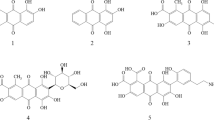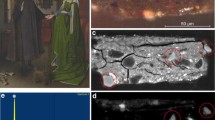Abstract
The Dama de Elche (4th–5th century B.C.), an emblematic piece of the ancient Iberian culture, was first sculpted in fossiliferous limestone of Tertiary Age. In this first systematic study, two classic pigments have been identified: Egyptian blue, prepared with a potassium flux, and natural vermilion applied over a preparation layer of gypsum, mixed with calcium carbonate, that migrated and recrystallized on the polychrome surface of the bust, process favoured by the change suffered after its disinterment. No anachronisms have been found on the identified polychromy, the existing coating surface nor any other element that might suggest it to be a modern forgery.
Résumé
La Dama de Eleche, sculpture emblématique de la culture ibère, fut taillée en pierre calcaire avec des fossiles de l'ère tertiaire. Dans cette première investigation systématique, on a identifié deux pigments classiques: le bleu égyptien, préparé avec un fondant potassique, et le vermillon naturel, appliqués sur une couche de préparation en plâtre, mélangé avec de la chaux, qui a migré et a recristallisé sur la surface polychrome du buste. Ce procédé a été aidé pour les changements subis après son déterrement. On n'a pas trouvé d'anachronisme en ce qui concerne les pigments et la couche de préparation. Aucun élément ne permet, de déduire que la sculpture puisse être un faux moderne.
Similar content being viewed by others
References
Paris, P., ‘Buste espagnol de style gréco-asiatique trouvé à Elche’,Monuments et Mémoires 4 (2) (Fondation E. Piot, Paris, 1898) 1–32.
Abad, L. and Bendala, M., ‘Iberian Art’,Historia del Arte 10 (Historia 16, Madrid, 1989) [only available in Spanish].
VVAA, ‘The Dama de Elche. Beyond the Eingma’, (Generalitat Valenciana,’ Valencia, 1997) [only available in Spanish].
Garcia y Bellido, A., ‘The Dama de Elche’, (Consejo Superior de Investigaciones Cientificas—CSIC, Madrid, 1943) [only available in Spanish].
Negueruela, I., ‘The Iberian Sculpture’, inCuadernos de Arte Español 57 (Historia 16, Madrid, 1992) [only available in Spanish].
Quesada, F., ‘Archaeology or science fiction?’,Misterios de la Arqueologia 1 (7) (1997) 8–11 [only available in Spanish].
Blanco, A., ‘The Iberian sculpture, an interpretation’, in ‘Escultura Ibérica’ (Zugarto, Madrid, 1987) 32–47 [only available in Spanish].
VVAA, ‘A Hundred years of a Dama’, (Spanish Ministry of Education and Culture, Madrid, 1997) [only available in Spanish].
Moffit, J., ‘Art Forgery. The Case of the Lady of Elche’, (Florida University Press, Florida, 1994).
Samaniego, F., ‘The Dama does not admit experiemnting’,El Pais 10 (July 1997) 39 [only available in Spanish].
Vives, F., ‘The Dama, de Elche’,Arqueo 1 (5) (2002) 80–89 [only available in Spanish].
‘Encyclopaedia Britannica. Lady of Elche’, (http://www.Britannica.com Inc., 1999–2000).
Ramos, R., ‘The Dama de Elche’ (Albatros, Valencia, 1997) [only available in Spanish].
Mélida, J.R., ‘Arqueología Española’ 2nd Edn. (Labor, Barcelona, 1942) [only available in Spanish].
Folk, R.L., ‘Spectral subdivision of limestone types’ in Classification of Carbonate Rocks1, W.E. Ham, Ed. (Am. Assoc. Petrol. Geol. Mem., Tulsa OK, 1962) 62–84.
Dunham, R.J., ‘Classification of carbonate rocks according to depositional texture’ in Classification of Carbonate Rocks1, W.E. Ham, Ed. (Am. Assoc. Petrol. Geol. Mem., Tulsa OK, 1962) 108–121.
Geological Map of Spain. Elche (1:50000), page no 893/28-35, (Instituto Geológico y Minero de España—IGME, Madrid, 1972) 11–14 [in Spanish].
Kriensley, D.H., Boogs, P.K. and Tovey, S.Jr., ‘NK. BSEM and Image Analysis of Sediments and Sedimentary Rocks’ (Cambridge University Press, New York, 1998).
Arnold, A. and Zhender, K., ‘Crystallization and habits of salt efflorescence on wall. I and II Conditions of Crystallization’, Proceedings of 5th Int. Cong. on Deterioration and Conservation of Stone, Lausanne, 1985, 269–277.
Colinart, S., Delange, E. and Pagès, S., ‘Couleurs et pigments de la peinture de l'Égypte Ancienne’,Techne 4 (46) (1996) 29–45.
Bruquetas, R., ‘Techniques and Materials of the Spainsh Saint during the Golden Centuries’ (Fundación de Apoyo a la Historia del Arte Hispánico—Fundación Telefónica, Madrid, 2002) [only available in Spanish].
Dorrego, F. and Luxán, M.P. de, ‘Pigments. From Empirism to Science’ (Munilla, Madrid, in press) [only available in Spanish].
Riederer, F.J., ‘Egyptian Blue’ inArtists' Pigments3, E. W. Fitzhugh, (Oxford Univ. Press, New York, 1997) 23–45.
Gettens, R.J., Feller, R.L. and Chase, W.T., ‘Vermilion and Cinnabar’ in Artists' Pigments2, A. Roy, Ed. (Oxford Univ. Press, New York, 1993) 159–182.
Pliny, C., ‘Natural History’ (Sanchez, Madrid, 1624).
Vitrubio, M., ‘The Ten Books of Architecture’, Facsimil Edn. (Akal, Madrid, 1987, 1992) [only available in Spanish].
Mollfulleda, J., ‘Cinnabar’, in ‘Minerales Descripción y Clasificación, (Omega, Barcelona, 1996) 100–102 [only available in Spanish].
Prada, J. L., Ruiz, S. and Quiles, M., ‘New Techniques of identification and differentiation of pigments of mercury sulphide from natural and artificial origin (Cinnabar-Vermilion) in cultural and historical heritage’,Fontónica y Arte XXI (2001) 121–129 [only available in Spanish].
Author information
Authors and Affiliations
Additional information
Editorial note The “Eduardo Torroja” Institute (CSIC) is a RILEM Titular Member. Dra. M.P. de Luxán participates in RILEM TCs CUA ‘Concrete use of additions’ and RHM, ‘Repair mortars for historic buildings’. Dr. F. Dorrego also participates in RILEM TC RHM.
Rights and permissions
About this article
Cite this article
Luxán, M.P., Prada, J.L. & Dorrego, F. Dama de Elche: Pigments, surface coating and stone of the sculpture. Mat. Struct. 38, 419–424 (2005). https://doi.org/10.1007/BF02479310
Received:
Accepted:
Issue Date:
DOI: https://doi.org/10.1007/BF02479310




